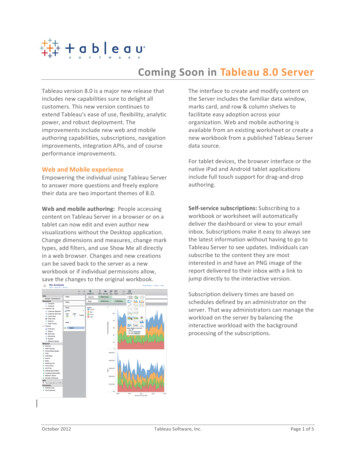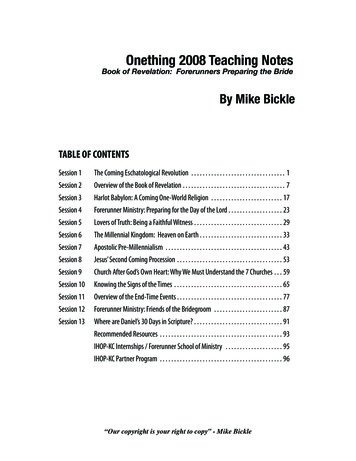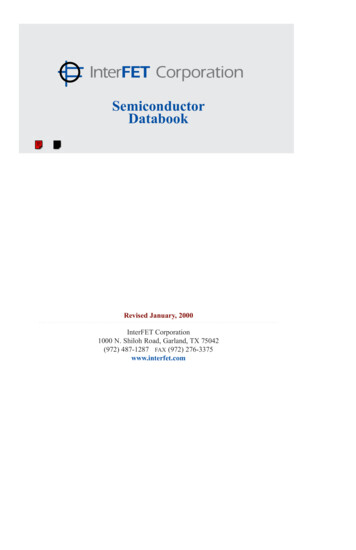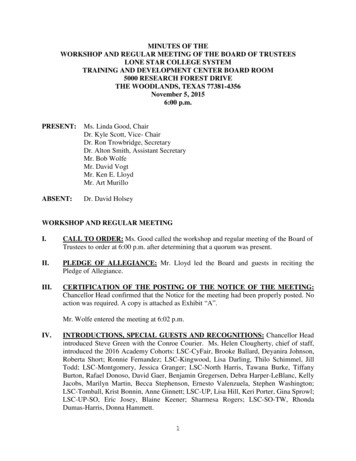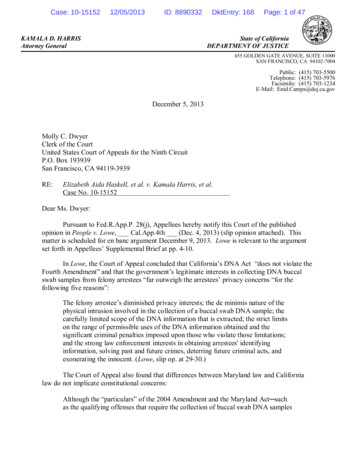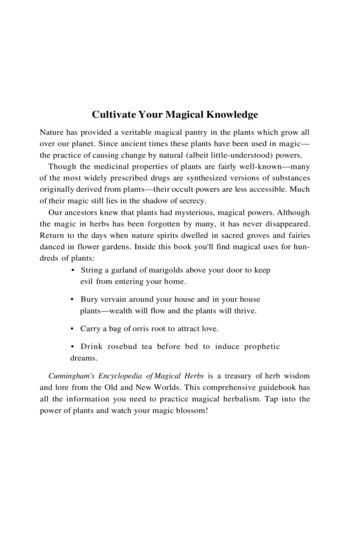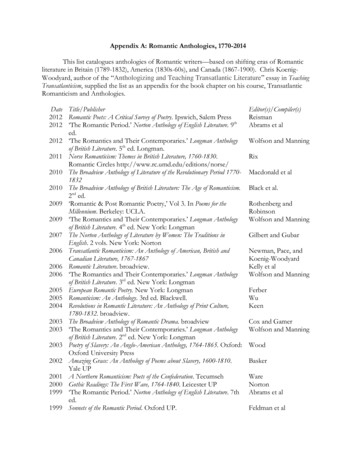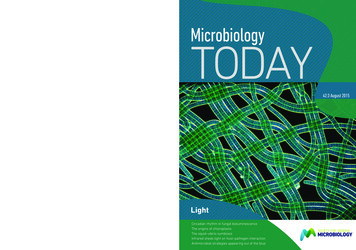
Transcription
Coming Soon from Garland ScienceNEW SECOND EDITIONMicrobiology: A Clinical ApproachMicrobiologyTODAYAnthony Strelkauskas, formerly of Trident TechnicalCollege, South Carolina, USA, Angela Edwards, TridentTechnical College, South Carolina, USA, Beatrix Fahnert,Cardiff University, UK, Greg Pryor, Francis MarionUniversity, USA, Jennifer Strelkauskas, Doctor ofVeterinary Medicine, Oregon, USAAs with the successful First Edition, the new edition ofMicrobiology: A Clinical Approach is written specificallyfor pre-nursing and allied health students. It is clinicallyrelevant throughout and uses the theme of infection as itsfoundation.For more information please contact y Features: Human stories added to the start of each chapter Section on the clinical identification of microbes added Thoroughly revised and updated, including major updates on microbiomes, emerginginfectious disease, vaccines, and antibiotic resistance Coverage of chemistry, genetics, and immunology has been simplified Revised end-of-chapter questions include: True/False, Matching, Ordering, and Reasoning Expanded Question Bank42:3 August 2015The textbook is supported with a robust ancillary packagefor instructors which will easily allow them to incorporatethe book’s new approach into their lectures. Studentsworking towards careers in the healthcare professions willachieve success with Microbiology: A Clinical Approach.Microbiology TodayAugust 2015Paperback650pp 630 illus978-0-8153-4513-8 60.00Microbiology is student-friendly: its text, figures, andelectronic resources have been carefully designed to helpstudents understand difficult concepts and keep theminterested in the material.42:3 August 2015LightCircadian rhythm in fungal bioluminescenceThe origins of chloroplastsThe squid–vibrio symbiosisInfrared sheds light on host–pathogen interactionAntimicrobial strategies appearing out of the blue
Presentation: Hard Gelatin Capsules.Indications: Typhoid fever and life-threatening infections, particularlythose caused by Haemophilus Influenzae, where other antibiotics willnot suffice.Posology: For oral administration.Adults and elderly: 50 mg/kg body weight daily in 4 divided doses. Forsevere infections (meningitis, septicaemia), this dose may be doubledinitially, but must be reduced as soon as clinically possible. Children:Not recommended.Contra-indications: Known hypersensitivity or toxic reaction tochloramphenicol or to any of the excipients. Should not be usedfor the prophylaxis or treatment of minor infections; during activeimmunisation; in porphyria patients; in patients taking drugs liable todepress bone marrow function; during pregnancy, labour or by breastfeeding mothers.Special warnings and precautions for use: Use only if other treatmentsare ineffective. Use should be carefully monitored. Reduce dose andmonitor plasma levels in hepatic or renal impairment; in the elderly; andin patients concurrently treated with interacting drugs.Interactions: Chloramphenicol prolongs the elimination, increasing theblood levels of drugs including warfarin, phenytoin, sulphonylureas,tolbutamide. Doses of anticonvulsants and anticoagulants may needto be adjusted if given concurrently. Complex effects (increased/decreased plasma levels) requiring monitoring of chloramphenicolplasma levels have been reported with co-administration of penicillinsand rifampicin. Paracetamol prolongs chloramphenicol half-life.Chloramphenicol may increase the plasma levels of calcineurin inhibitorse.g. ciclosporin and tacrolimus. Barbiturates such as phenobarbitoneincrease the metabolism of chloramphenicol, resulting in reducedplasma chloramphenicol concentrations. In addition, there may bea decrease in the metabolism of phenobarbitone with concomitantchloramphenicol use. There is a small risk that chloramphenicol mayreduce the contraceptive effect of oestrogens. Chloramphenicol reducesthe response to hydroxocobalamin. Chloramphenicol is contra-indicatedin patients taking drugs liable to suppress bone marrow functione.g. carbamazepine, sulphonamides, phenylbutazone, penicillamine,cytotoxic agents, some antipsychotics including clozapine andparticularly depot antipsychotics, procainamide, nucleoside reversetranscriptase inhibitors, propylthiouracil.Pregnancy and Lactation: The use of chloramphenicol is contraindicated as the drug crosses the placenta and is excreted inbreast milk.Effects on ability to drive and use machines: No significant effecton driving ability.Undesirable Effects: Reversible dose related bone marrow depression,irreversible aplastic anaemia, increased bleeding time, hypersensitivityreactions including allergic skin reactions, optic neuritis leadingto blindness, ototoxicity, acidotic cardiovascular collapse, nausea,vomiting, glossitis, stomatitis, diarrhoea, enterocolitis, Gray BabySyndrome particularly in the newborn, which consists of abdominaldistension, pallid cyanosis, vomiting, progressing to vasomotor collapse,irregular respiration and death within a few hours of the onset ofsymptoms.Overdose: Stop chloramphenicol immediately if signs of adverse eventsdevelop. Treatment is mainly supportive. If an allergy develops, oralantihistamines may be used. In severe overdosage e.g. Gray BabySyndrome, reduce plasma levels of chloramphenicol rapidly. Resinhaemoperfusion (XAD-4) has been reported to substantially increasechloramphenicol clearance.Pack size and Price: 60 capsules 377.00Legal Category: POM.Market Authorisation Number: PL17736/0075.Market Authorisation Holder: Chemidex Pharma Limited, 7 EghamBusiness Village, Crabtree Road, Egham, Surrey TW20 8RB, UK.Date of preparation: October 2014.See Chloramphenicol Capsules Summary of Product Characteristics forfull prescribing information.Adverse events should be reported. Reporting forms andinformation can be found at www.mhra.gov.uk/yellowcard.Adverse events should also be reported to EssentialGenerics on 01784 477167.References:1. Martindale: The Complete Drug Reference. Chloramphenicol. [Online].Available from: http://www.medicinescomplete.com [Accessed 18thAugust 2014]. 2. Fluit, A.C., Wielders, C.L.C., Verhoef, J., and Schmitz,F.J. Epidemiology and susceptibility of 3,051 Staphylococcus aureusisolates from 25 university hospitals participating in the EuropeanSENTRY Study. Journal of Clinical Microbiology. 2001; 39(10):3727-3732. 3. Weigel LM et al. High-level vancomycin-resistantStaphylococcus aureus (VRSA) associated with a polymicrobial biofilm.Antimicrobial Agents and Chemotherapy. Published online ahead ofprint on 30th October 2006. http://aac.asm.org/cgi/reprint/AAC.0057606v1.pdf. (Accessed on 22nd August 2011). 4. Kelly, C., LaMont,T. Patient information: Antibiotic-associated diarrhea (Clostridiumdifficile). www.uptodate.com. 2011. 5. Feder. H, Chloramphenicol: Whatwe have learned in the last decade. Southern Medical Journal. 1986;(79)9: 1129-34. 6. Ensminger, P., Counter, F., Thomas, L., Lebbehuse,P. Susceptibility, resistance development, and synergy of antimicrobialcombinations against Clostridium difficile. Current Microbiology.1982; 7: 59-62. 7. Poilane, I., Bert, F., Cruaud, P., Nicolas-Chanoine,MH., Collignon, A. Interest of the disk diffusion method for screeningClostridium difficile isolates with decreased susceptibility to antibiotics.Pathologie Biologie (Paris). 2007; 55(8-9): 429-33. 8. Cattoir, V.,Ould-Hocine, ZF., Legrand, P. Antimicrobial susceptibility of Clostridiumdifficile clinical isolates collected from 2001 to 2007 in a Frenchuniversity hospital. Pathologie Biologie (Paris). 2008; 56(7-8):407-11. 9. Brazier, JS., Levett, PN., Stannard, AJ., Phillips, KD., Willis,AT. Antibiotic susceptibility of clinical isolates of clostridia. Journal ofAntimicrobial Chemotherapy. 1985; 15(2): 181-5.CAPSULESPIP: 106-5796AAH: CHL600BALLIANCE: O65995For further information, please contact: Essential Generics, 7 Egham Business Village, Crabtree Road, Egham, Surrey TW20 8RB, UKMOVIANTO: CHL25060Essential Generics: Chloramphenical AdSupply as hi-res PDF Job no: 23884EG/CH/JAN/2015/09Abbreviated Prescribing InformationChloramphenicol Capsules BP 250mgBleed: 3 mmEffective against seriousinfections including:H. influenzae ckettsia1,2C.difficile 6-9E. coli 1Journal: Microbiology TodayRarely implicated with C.difficile 3Size: 297 x 210 mmOral levels comparable to i.v. levels2CHLORAMPHENICOLWidely distributed throughout the body, including CSF1We’ve had 70 years experience supporting our membersto advance their careers and professional development.We can do the same for you when you join theSociety for General Microbiology. Membership starts from just 28.Call 44 (0)20 7685 2691 or email members@sgm.ac.ukto join now, or visit www.sgm.ac.uk for further information.
Editorial2015 is the International Year of Light and Light-basedTechnologies. This International Year intends to bring togethergroups to provide solutions to global challenges in areas suchas energy, education, agriculture and health. Light is so verycrucial to our existence, it is woven into the very fabric of ourlives and our being. It is composed of a myriad of wavelengths,energies and colours, and as a species we have evolved tocapture, split and create light.Personally, I have a dualrelationship with light. I am awarethat I often take its presencefor granted; it only emerges into myconsciousness when it disappears andwe return to darkness at night. Formillennia, societies have learnt to usethis relentless pattern of light and darkto mark existence and measure time.This cadence of light and dark playsa vital role in providing the inherentdrivers for the circadian rhythms thatunderpin our daily lives. These rhythmsare not restricted to humanity butpervade the microbial world. Hans E.Waldenmaier, Anderson G. Oliveira,Jennifer J. Loros, Jay C. Dunlap andCassius V. Stevani have written an articlethat describes the circadian rhythm thatunderpins fungal bioluminescence. Theyillustrate how studies on the Brazilianmushroom Neonothopanus gardneri isrevealing clues about ‘how’ and ‘why’fungi produce light.Humanity has studied, tested,understood and described how thefundamental energy of light can becaptured and transformed into thebasic building blocks of life. It is thiselemental feature of light that wasone of the reasons that I chose tostudy biochemistry. The biochemistryof chloroplasts has always held anenduring fascination for me and Iam intrigued by the concept thatchloroplasts are microbes ‘captured’by other cells. Phoebe Tickell andRichard G. Dorrell provide an insightinto this process and explain how werely on plants and algae to make useof light energy, through the process ofphotosynthesis. Cyanobacteria (‘bluegreen algae’) invented the main formof photosynthesis we see today, and itis used by a wide range of eukaryotes,from unicellular algae and giantseaweeds in the oceans to plants thatflourish on land, and common to allthese organisms are the cyanobacterialike chloroplasts. In many ways thisrelationship can be considered as theultimate symbiosis. Tim Miyashiro’sarticle outlines a symbiotic relationshipthat has facilitated our understandingof how symbioses between animalsand bacteria developed and evolved.It describes how bioluminescence isemitted by populations of a marinebacterium called Vibrio fischeri housedwithin a dedicated structure calledthe ‘light organ’ of the bobtailed squid,Euprymna scolopes.Light has revolutionised medicine,and this is pertinent to microbiology andhuman health. Tom Grunert discusseshow we can take advantage of theinfrared region of the spectrum toprovide a unique fingerprint signature ofintact microbial cells in order to improve andincrease our ability to identify pathogens.This development reflects the fact thatthe metabolic state of bacteria can bedetermined from absorption patterns fromthis part of the spectrum. Michelle Maclean,John G. Anderson and Scott J. MacGregordescribe how bacterial inactivation usingviolet-blue light has emerged as an area ofinteresting research. Although less biocidalthan ultraviolet (UV) light, visible violetblue light (the narrow wavelength bandcentred on 405 nm) has proved effective forinactivation of a range of microbial species,which is generating interest in healthcareand food facilities.Capturing scientific images is afundamental part of enhancing scientificknowledge and understanding. KevinMackenzie provides a commentary thatoutlines how this process has changed anddeveloped over time, as our ability to uselight to capture images reflects modernadvances and new technologies.This edition of Microbiology Todaynot only looks forward to the future but itprovides an understanding of how historicalsteps in microbial evolution underpin thevery essence of our modern lives.Laura BowaterEditorlaura.bowater@uea.ac.ukMicrobiology Today Aug 15 www.sgm.ac.uk 89
ContentsMicrobiologyTODAYArticles98Circadian rhythm in fungalbioluminescence: nature’s bright ideaHans E. Waldenmaier, Anderson G. Oliveira,Jennifer J. Loros, Jay C. Dunlap & Cassius V. StevaniThe how and why of Neonothopanus gardneri’s luminescence.102Going green through co-operation:the origins of chloroplastsPhoebe Tickell and Richard G. DorrellEndosymbiosis and the evolution of photosynthesising eukaryotes.106The curious meeting of two partners:the squid–vibrio symbiosisTim MiyashiroAn illuminating host–microbe model aiding discovery.110Infrared sheds light on host–pathogeninteractionTom GrunertA tool to better understand bacterial metabolic processes.114New antimicrobial strategiesappearing out of the blueMichelle Maclean, John G. Anderson &Scott J. MacGregorViolet-blue light technology to inactivate microbes.
42:3 August 2015FeaturesRegulars118 The Society’s journals move to a newonline platform and get a fresh look andfeel89Editorial92Council 201593From the President94From the Chief Executive95News120Conferences134ReviewsFind out how our publishing platform and branding have changed.122 Microbiology MattersOur policy activities and agenda have been reviewed with our members.124 Schoolzone – Playing with lightThree intriguing experiments using light.127 XIIIth Annual UK Workshop on ArchaeaAn overview of the workshop and the plans for next year.128 How can Society grants support yourcareer?Get some ideas and find out when you can apply.Editor Dr Laura BowaterManaging Editor Ruth PagetEditorial Board Phil Aldridge, David Bhella, Helen Brown, Alan Cann,Lorena Fernández-Martínez, Ian Henderson, Paul Hoskisson,Gavin ThomasAddress Society for General Microbiology, Charles Darwin House, 12 RogerStreet, London WC1N 2JU T 44 (0)20 7685 2683 E mtoday@sgm.ac.ukDesign Ian Atherton, Corbicula Design (www.corbiculadesign.co.uk)Printed by Charlesworth Press, Wakefield130 Primary School outreach: inspiringyoung minds with scienceUniversity of Oxford’s outreach activities in Manchester. 2015 Society for General MicrobiologyISSN 1464-0570The views expressed by contributors do not necessarily reflect official policy of the Society; nor canthe claims of advertisers be guaranteed.132 Membership Q&ASuparna Mitra, senior research scientist, tells us about her career.FSC Logo133 Best of the blogA round up from earlier in the year.135 Comment – View from a microscopeKevin MackenzieKevin outlines how microscope imaging has changed.Light micrograph of afilamentous blue-green algae(Cyanophycophyta), calledOscillatoria sp. Sinclair Stammers /Science Photo Library
Council 2015Executive OfficersPresident – Professor Nigel L. BrownUniversity of Edinburgh, c/o Society for General Microbiology, Charles Darwin House, 12 Roger Street, London WC1N 2JU; president@sgm.ac.ukGeneral Secretary – Dr Evelyn M. DoyleSchool of Biology and Environmental Science, Science Centre West, University College Dublin, Belfield Dublin 4, Ireland; evelyn.doyle@ucd.ieTreasurer – Professor Chris ThomasSchool of Biosciences, University of Birmingham, Edgbaston, Birmingham B15 2TT; c.m.thomas@bham.ac.ukElected MembersProfessor Andrew DavisonMRC-University of Glasgow Centre for Virus Research, Church Street, Glasgow G11 5JR; andrew.davison@glasgow.ac.ukDr Stephen DiggleSchool of Life Sciences, Centre for Biomolecular Sciences, University of Nottingham, University Park, Nottingham NG7 2RD; steve.diggle@nottingham.ac.ukDr Pat GoodwinC3 Collaborating for Health, c/o Society for General Microbiology, Charles Darwin House, 12 Roger Street, London WC1N 2JUProfessor Ian R. HendersonDivision of Immunity & Infection, University of Birmingham Medical School, Edgbaston, Birmingham B15 2QU; i.r.henderson@bham.ac.ukProfessor David PearceFaculty of Health and Life Sciences, Northumbria University, Northumberland Road, Newcastle-upon-Tyne NE1 8ST; david.pearce@northumbria.ac.ukDr Mike SkinnerSection of Virology, Imperial College London, Faculty of Medicine, St Mary’s Campus, Norfolk Place, London W2 1PG; m.skinner@imperial.ac.ukChairs of CommitteesCommunications Committee – Dr Paul A. HoskissonStrathclyde Institute of Pharmacy & Biomedical Sciences, University of Strathclyde, 161 Cathedral Street, Glasgow G4 0RE; paul.hoskisson@strath.ac.ukFinance Committee – Professor Chris ThomasSee “Treasurer” aboveProfessional Development Committee – Dr David WhitworthInstitute of Biological, Environmental and Rural Sciences Room S22, Cledwyn Building, Aberystwyth University, Ceredigion SY23 3FG; dew@aber.ac.ukPolicy Committee – Professor Maggie SmithDepartment of Biology, University of York, Wentworth Way, York YO10 5DD; maggie.smith@york.ac.ukPublishing Committee – Professor Charles DormanDepartment of Microbiology, Moyne Institute of Preventive Medicine, Trinity College Dublin, College Green, Dublin 2, Ireland; cjdorman@tcd.ieScientific Conferences Committee – Professor Mark HarrisSchool of Molecular and Cellular Biology, Faculty of Biological Sciences, University of Leeds, Leeds LS2 9JT; m.harris@leeds.ac.uk92 Microbiology Today Aug 15 www.sgm.ac.uk
From the PresidentThis edition of Microbiology Today comes at an importanttime for the Society. Next month’s Annual General Meetingwill consider a series of announcements and decisions.Council, Committees and Divisions, and we will find outwho the next President will be.The major decision for membersto make is on the recommendationfrom Council that the Societychanges its name. As I mentioned inmy introduction to Microbiology Today inFebruary, the word ‘general’ has a verydifferent connotation now comparedwith 70 years ago when the Society wasformed.Peter Cotgreave gives some of thedetail behind the proposal to change theSociety’s name on page 94. While wemay be comfortable with the existingname, it does not mean much externally,and we need increasingly to think ofour external audiences. Along withthe changing name comes a changingstrategy to meet a changing world, butour core values and mission have notchanged. We are merely delivering thesedifferently.In addition to the Annual GeneralMeeting on 17 September, it is also theopportunity to hear the presentationsof the finalists in the Sir HowardDalton Young Microbiologist of theYear Competition. I am sure that, as inprevious years, the standard of scienceand its presentation will be very high.At the same event, one of ourdistinguished Honorary Members,Professor Dame Anne Glover, will giveour Special Lecture. Anne founded acompany based on her research at theUniversity of Aberdeen, and was ChiefScientific Adviser for Scotland beforebecoming Chief Scientific Adviser to thePresident of the European Commission.She was awarded a DBE in the 2015Birthday Honours List. She has beenheavily engaged in policy work forseveral years, and her talk should beinstructive and fascinating.As many of you know, I am keenthat the Society engages on majorpolicy issues and the work of thePolicy Committee has made thishappen. Several of the issues that areimportant internationally – antimicrobialresistance, bioenergy, waste remediation,infectious disease, food security – havea strong microbiology component. It isimperative that our voices are heard onsuch issues and our expertise brought tobear.As well as communicating withpolicy-makers and external audiences,we also need to inform each other.Our excellent Annual Conference fourmonths ago saw the launch of thelatest journal in the Society’s portfolio.Microbial Genomics fills a gap in journalprovision internationally, and I wish itevery success. Of course, success can behelped by members publishing in this orone of our other journals. These are ourmain income stream and allow us to dothe many things we have identified in ourIan AthertonWe will learn who has been successful in the elections tostrategy. Our conferences would besorry or expensive affairs without thesupport of the journals. I am grateful forthe vision of our Publishing Committeeand staff in developing our activities inthe changing environment of scientificpublishing.This year is the International Yearof Light and this edition of MicrobiologyToday focuses on microbial interactionswith light – both in responding to lightand in generating light. How many peopleknow that micro-organisms are the maincontributors to utilising the sun’s energythrough photosynthesis, or that theygenerate the beautiful phosphorescenceseen on some tropical beaches? Asmicrobiologists, we should be tellingpeople about such things as well astelling them about micro-organismsand disease. Of course, the history ofmicrobiology has also been the historyof light microscopy, from Leeuwenhoek’sobservations of ‘animalcules’ to thesophisticated optical techniques oftoday. Light has played an importantrole in microbiology from the discipline’sinception and I hope that you find thisedition of Microbiology Today illuminating!Nigel BrownPresidentpresident@sgm.ac.ukMicrobiology Today Aug 15 www.sgm.ac.uk 93
From the Chief ExecutiveThis issue of Microbiology Today comes with the papers for theSociety’s Annual General Meeting on 17 September. You will seethat they contain a proposal from Council that we operate under anew name: Microbiology Society. The reason is simple. We believethe change will allow us to maximise our effectiveness in thescientific community and in the wider world. The proposal hasarisen as Council has reviewed and revised its strategic plansfor the coming years.The core priorities of the Society, thethings that matter to members, areof course not changing: world-classconferences, journals publishing themost interesting microbiology research,professional development opportunitiesfor members, influence in key policyareas, education and communicationwith the wider public. What is new isa reinvigorated effort by Council andthe staff to link these activities morecoherently, so that the Society canhave maximum impact on behalf of ourmembers. The Society’s key strength isthe depth and wealth of knowledge amongthe diverse membership in academia,industry, charities and public service;the revised plans for implementing thestrategy will allow us to optimise howwe apply this knowledge for the publicgood, addressing problems in healthcare,environmental, economic and socialsettings.These changes follow extensiveconsultation. Last year we conducteda survey of the membership, this yearwe have spent time drilling down intoyour interests with individuals andgroups of members in conversations andworkshops. The staff, Committees andCouncil have held their own discussionsand seminars, and we have spoken toexternal constituencies in the media, thepolicy world, and among funders.Members want the Society to beambitious and bold, to keep evolvingand improving, so that we can continueto achieve our founding purpose of‘advancing the art and science ofmicrobiology’, and to press towardsCouncil’s vision: a world in whichthe science of microbiology providesmaximum benefit to society.Changing the name to MicrobiologySociety will help us to do this. In part,this is simply because the everydayuse of the word ‘general’ has changed.When our visionary founders namedthe organisation, the word had entirelypositive connotations, expressing theirdesire to offer something valuablefor all parts of the microbiologycommunity. Today, it is more often usedto imply a lack of focus. But the needfor change is not merely about subtleshifts in language. Seven decadesago, the Society concerned itselfalmost exclusively with the scientificcommunity; researchers instantlyunderstood that the Society’s title wasa short-hand to embrace the diversityof prokaryotes, viruses and eukaryoticmicrobes. In today’s world, we muststill focus relentlessly on the needsand concerns of microbiologists, butthrough projects like the Small WorldInitiative, we also need to ensure thatthe wider public, policy-makers, schoolpupils and others can engage with thecrucial importance of our subject. To94 Microbiology Today Aug 15 www.sgm.ac.ukthese constituencies, our current name isslightly opaque and a bit of a mouthful.‘Microbiology Society’ says it all inthe fewest words and simplest form. Ourbusiness is microbiology in all its infinitebeauty and diversity, and we are a societyof like-minded individuals who cometogether to support one another in movingthe field forward.Changing the name of an organisationafter 70 successful years is a big step.Council’s proposal is not about changingthe Society’s core identity, it is aboutpreserving it, and helping us to do our jobeven more effectively in the future. Theworld may have changed around us butthe fundamental principles of our Societyhave not. The ambition of our founderswas timeless: “that workers in the variousfields of microbiology might find commonground and better opportunities formaking contact with one another”.Under a new name – MicrobiologySociety – the members, Council, staff andCommittees will continue to work to makethis a reality, so that you can developyour careers in the fascinating subject ofmicrobiology, and so your expertise andexperience can have the biggest possibleimpact in the world.Peter CotgreaveChief Executivep.cotgreave@sgm.ac.uk
NewsAnnual General MeetingNew publishing platform and rebranded journalsThe Annual General Meeting (AGM) of the Societyfor General Microbiology will be held on Thursday, 17September 2015 at 16:00 in the Auditorium of CharlesDarwin House, 12 Roger Street, London WC1N 2JU.All those eligible to vote – Full, Full Concessionary,Postgraduate Student and Honorary Members – shouldhave received the relevant papers with this issue ofMicrobiology Today.The day will also feature presentations from theYoung Microbiologist of the Year Finalists, theMicrobiology Outreach Prize winner and a SpecialLecture from Professor Dame Anne Glover, formerChief Scientific Adviser of the European Commission.All members are invited to attend what promises tobe an informative and enjoyable afternoon, with ampleopportunity to network during a drinks reception afterthe day’s activities. If you would like to attend theAGM, please email Rosie Waterton in advance atr.waterton@sgm.ac.uk. The agenda can be foundonline: www.sgm.ac.uk/agm.Events build links between scienceand policyThe Society’s policy team attended two events inMay, at the Senedd in Cardiff and the Houses ofParliament, which saw the strengthening of linksbetween the science community and policy-makers.At Science and the Assembly in Cardiff, attendeesheard a series of scientific presentations on the themeof ‘Energy and the Environment’, which was followedby an exhibition and reception where Members of theWelsh Assembly liaised with scientists and the learnedsocieties. At Parliamentary Links Day in Westminster– the first major science policy event of the newparliament – an audience including MPs, Lords andCivil Servants heard talks about ‘Science and theNew Parliament’.Find out more about the policy team’s work on p. 122.The Society’s publishingteam have launched a newonline platform where all ourpeer-reviewed journal articlescan be viewed. The journalshave also been rebranded ina modern and contemporarydesign that fits with ourcorporate identity.Find out more on p. 118.2015 Young Microbiologist of the YearFinalists announcedThe Society is delighted to announce the eight finalists for the annualSir Howard Dalton Young Microbiologist of the Year Award. The prizerecognises and rewards excellence in science communication as thefinalists are selected by the Society Divisions from their presented posteror oral at the Society’s Annual Conference or Irish Division Meeting.The 2015 finalists are:Virology DivisionEleonora Melzi, University of GlasgowBen Krishna, University of CambridgeEukaryotic DivisionAndrew Watson, Newcastle UniversityChristopher Miller, University of KentProkaryotic DivisionMegan de St Croix, University of LeicesterJoseph Kirk, University of SheffieldIrish DivisionStephanie Flynn, University of CorkSamantha Chui-Sang Lee, National University of Ireland and the MarineInstitute GalwayThe eight finalists will each give a presentation of their work at theSociety’s AGM and 70th anniversary event on 17 September 2015.The first, second and third prizes will be awarded after the AGM at theSociety’s President’s Dinner.Microbiology Today Aug 15 www.sgm.ac.uk 95
96 Microbiology Today Aug 15 www.sgm.ac.uk
Microbial GenomicsThe first articles in the Society’snewest online-only, open accessjournal, Microbial Genomics (MGen), werepublished last month and are free toread on the journal’s website. MGen hasalso introduced a new section called‘Standing on the Shoulders of Giants’,featuring interviews with pioneers inbiology, who have contributed to the fieldof microbial genomics, and dedications toground-breaking articles, all selected byour editorial board members. MGen hasa gold open access policy, high-qualitypeer-reviewing system and features amandatory open data policy. Readthe journal or submit your article atwww.mgen.sgmjournals.org.European Congress ofVirol
Microbiology: A Clinical Approach is written specifically for pre-nursing and allied health students. It is clinically-relevant throughout and uses the theme of infection as its foundation. Microbiology is student-friendly: its text, figures, and



